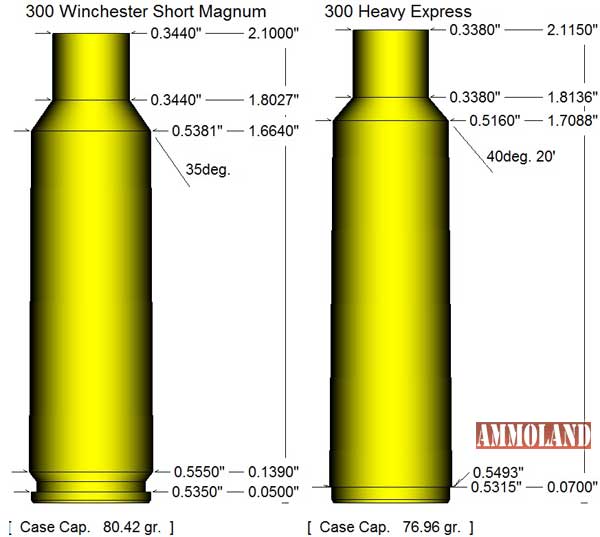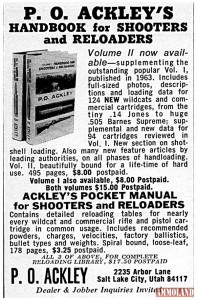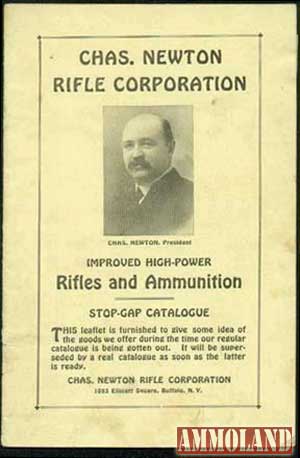So, You Think You Don’t Like Wildcat Cartridges?
Check out the cartridges available from the various firearms and ammunition makers, you will find that nearly all were once wildcats.
By Fred Zeglin


Kalispell, MT –-(Ammoland.com)- When cartridge choice comes up in most any group of shooters there is always at least one guy who says with a certain amount of disdain, “With all the choices of cartridges I have from the factories, why would I shoot a wildcat?”
This question has been asked almost as long as wildcatting has been going on.
In all fairness, even an avid wildcatter like myself has to agree with the logic of that question.
Today we have a wider variety of cartridges and calibers than at any time in the past. The various ammunition makers and firearms manufacturers have brought numerous new cartridges to the market in an effort to entice new purchases from the shooting public. There are countless reasons or as I like to say excuses for releasing a new cartridge, but for the factories it boils down to the simple fact that they are in business and need their products to sell.
Velocity, Accuracy & Clever Combinations
Over the decades wildcatters have continually pushed the envelope, looking for better designs, more velocity, accuracy, and clever combinations of caliber and firearm. It’s not always a desire for more horse power that drives design, when P.O. Ackley started making 17 caliber barrels it was certainly not dangerous game that he had in mind. In about 1943 Charlie O’Neil asked P.O. Ackley to make a 17-caliber barrel for him. With the war effort in full swing, Ackley had trouble acquiring the tooling and did not get the barrel made up until 1945. By then O’Neil had lost interest in the project. The first cartridge that Ackley made up in 17 caliber was the 17 Pee Wee, a necked down 30 Carbine case.
This was true wildcatting, how many reloaders today make their own bullets, especially out of necessity? The first 17 caliber bullets were made from copper wire swaged in a die in Ackley’s shop.

It quickly became obvious that there were no actions that would readily handle the 17 Pee Wee and surplus .30 Carbines were still years away from the market. Consequently Ackley quickly realized the need for more useful cartridges in 17 caliber. So, he moved on to the 17 Ackley Hornet, 17 Ackley Bee, and eventually the 17/222. In his “Handbook for Shooters and Reloader”
Ackley stated that, “Experience has shown that the 222 Remington simply necked down without any other change is about the best, and most easily made since it requires no trimming or fire forming. This cartridge is about maximum capacity for the 17 bore and only a slight increase in velocity has been possible by necking down larger cases.”
The lineage of the 17 Remington is clear, it goes back directly to Ackley’s work with the 17 caliber.
22 caliber cartridges are far more popular and common when compared to 17’s. Perhaps you think the 22-250 is a factory offering of a 250 Savage case necked down to 22.
Well, yes and no. The history of this cartridge is far more complex and interesting than that. It is hotly contended that Grosvenor “Grove” Wotkyns promoted the work of gunsmith J.B. Sweany as the originator of the 22-250 in the early 1930’s. Harvey Donaldson submitted a version of the 22-250 to Savage Arms in 1935, although it was designed for a .227” bullet like the 22 Savage Hi-Power. By 1938 Jerry Gebby and J.B. Smith advertised chambering rifles in 22-250.

So who was first with the 22-250?
None of the above. Charles Newton gave a sample of an experimental cartridge he had abandoned for pressure problems to Jerry Gebby. It was a 250 Savage case neck for a .226” bullet. It was 1919 when Gebby paid his visit to Newton and received the sample. Charles Landis, gun writer, mentions having corresponded with Newton about just such a cartridge way back in 1905.
When Gebby reworked the idea he standardized on the .224” bullet. Changes in brass quality and available powders made Gebby’s new version of the case viable, he called it the 22 Varminter. Yes, more than one gunsmith was working with the idea of a 22-250, it was 1965 when Remington caught up with wildcatters and adopted the 22-250.
Remington stumbled when they first brought out the 244 Remington. Somebody at the company decided that this would be a varmint class cartridge so it was only available with bullets under 90 grains from the factory. Remington chose a 1 in 12 twist for the barrels in the 244 which would not stabilize bullets 100 grains or heavier.
Generally, the shooting public likes flexibility in their rifles; being able to use the same rifle for varmints and deer/antelope class game is popular. Remington solved this problem several years later when they renamed the cartridge to 6mm Remington. The only change was the twist rate offered in the barrels, the name change was designed to get away from the negative limitations of the 244 Remington. With all that said this cartridge is clearly the brainchild of Fred Huntington of RCBS fame. His wildcat was called the 243 Rockchucker; while the two cases are not mechanically interchangeable they are ballistically identical.
Shortly after the introduction of the 338 Winchester in 1958, P.O. Ackley was approached by his long time friend Les Bowman to make a 7mm Magnum on the 338 Winchester case. Ackley had a similar cartridge in his own line of magnum calibers known as the 7mm Ackley Magnum so he had a good idea what the cartridge would do.
The final design for the 7mm Remington was hardly changed from the wildcat that Ackley chambered for Bowman.
There were a number of other wildcats that preceded the 7mm Remington Magnum. The 7×61 Shape & Hart was a quasi factory offering but has spent most of its existence as a wildcat. Bill Williams and Art Mashburn two well-known wildcatters also had 7mm Magnum designs in the same general size and shape. Bowman was friendly with Mike Walker and Wayne Leek at Remington and had their ears concerning the development of a 7mm Magnum for the company. Walker was an avid shooter in his own right and likely knew of most of the 7mm Magnums popular with wildcatters at the time.
New & Unique Wildcats
Wildcatters like to believe that whatever they come up with is new and nobody has done it quite that way. Sometimes this is true, but more often than not its no more than wishful thinking. A great example of this is the current rash of short magnums (like the 300 WSM see image above) by all the various factories; one former gun writer even has a patent on the concept and thinks he can defend it. Truthfully it is not a new idea and has been around for many years. A well-known early cousin of this idea is the 35 Greevy Express, which appeared in the mid 1970’s. This was a 45-70 case necked down to 35 caliber with an overall length of 2.100”.
Before his 1962 publication of “Handbook for Shooter and Reloaders”, Ackley introduced a 35/348 Ackley Improved that has the same basic case capacity and it just a little longer. Then Remington had the 6.5mm and 350 Remington Magnums, which originated in the mid 1960’s, and had dropped off the map in recent years. The 350 Remington Magnum was reintroduced in 2002 with all the excitement about short magnums sweeping the shooting world.
Another group of cartridges that are clearly in the family tree of the short magnum were popular just before the introduction of the WSM and RSAUM families, these were the Heavy Express cartridges made from 348 Winchester cases shortened and neck to various calibers. The rim of the 348 case was turned down and a rebated case was created to suit the magnum bolt face. It seems highly likely that the Heavy Express cartridges drew the attention of the factories as they were creating buzz and had found a niche that no commercial cartridge then available could.
The next time you hear someone make that familiar statement, “With all the choices of cartridges I have from the factories, why would I shoot a wildcat?” Now you have fodder for an interesting conversation.
Check out the cartridges available from the various firearms and ammunition makers, you will find that nearly all were once wildcats.
So maybe your buddy at the range is just shooting a wildcat that has become passé with it’s adoption by the firearms establishment, some guys are just behind the curve, tell him, “Yea, my Grand Pappy liked that cartridge.” Should make for a good conversation.
| 17 Remington | Developed from 17/222 by P.O. Ackley |
| 17 Fireball | 17 Mach IV, marketed by O’Brien Rifle Co. 1960’s designed by P.O. Ackley |
| 204 Ruger | Suggested by P.O. Ackley in 1962 |
| 223 Remington | Developed by Bob Hutton of Guns & Ammo Magazine |
| 225 Winchester | Close copy of the 219 Zipper Ackley Improved |
| 22-250 | Attempted by Newton between 1915 &1919 later picked up by many others including Donaldson & Gebby |
| 220 Swift | Originated by Grosvenor Wotkyns 1934-35 |
| 6mm PPC | Started as wildcat in 1974, Sako adopted in 1987 |
| 6mm BR or Norma BR | Have their roots in the 308×1.5” originated by Frank Barnes in 1961 |
| 243 Winchester | 240 Page Pooper, writer Warren Page |
| 6mm (244) Remington | 243 Rockchucker, Fred Huntington, founder of RCBS |
| 250 Savage | Designed by Wildcatter Charles Newton in 1912 for Savage Arms, adopted 1914 |
| 257 Roberts | Designed by Ned H. Roberts in the 1920s, adopted by Remington with some changes 1934. |
| 25-06 Remington | Credited to A.O. Niedner 1920, Newton developed the 25 Special in 1909-12, adopted by Remington in 1969 |
| 260 Remington | 263 Express, Ken Waters, 1956. Numerous versions of the 6.5-308 have been around ever since. |
| 6.5-284 Norma | 6.5 Reindeer by Dr. E.L. Eichhorn, Bob Hutton and P.O. Ackley collaborated on a 6.5/284 before the brass was available to the public in 1963. |
| 270 WSM | Heavy Express, 35 Greevy 1970’s |
| 7-30 Waters | Started as Ken Waters pet project in 1976, adopted by Winchester in 1983 |
| 7mm-08 | Many gunsmiths offered this wildcat before 1958, Remington adopted it in 1980 |
| 280 Remington | Parents of the 280 Remington are the 7mm-06 and the 7x64mm Brenneke, Newton may be the first on this cartridge developing a 7mm Special in 1909-12 |
| 7mm Remington Magnum | Les Bowman & P.O. Ackley designed a 7mm-338; there were numerous other 7mm magnum wildcats that led to this development as well. |
| 7mm RSAUM | Heavy Express, 35 Greevy |
| 7mm STW | 7mm Mashburn, 288 Barnes Supreme were similar predecessors. |
| 300 WSM | Heavy Express, 35 Greevy |
| 308 Norma | Ackley 30 Short Magnums, or even earlier 30 Newton, 1913. |
| 8mm Remington Magnum | 323 Critser Magnum |
| 338 Federal | Numerous gunsmiths offered 338-08 from the day the 338 Winchester Magnum appeared. |
| 338-06 A-Square | 333 OKH dates back to 1945, in 1958 Winchester introduced the 338 Magnum so bullet availability created the 338-06 |
| 338 Winchester | 333 Ackley Short, 333×61 Carlson, 333 B-J Express all predated the 338 Winchester. |
| 35 Whelen | Townsend Whelen and James Howe collaborated on this cartridge well before World War II, it was 1987 that Remington adopted it. |
| 358 Norma | 35 Newton 1915, 358 Ackley Magnum originated in 1939, the Norma appeared in 1958. |
| 416 Remington Mag. | 416 Hoffman was around in the 1970s, the 416 Remington came along in 1988. |
| 458 Lott | Designed by Jack Lott in 1971 this cartridge was picked up by Hornady and Ruger in 2002. |
About Z-Hat Custom Inc.
Z-Hat is a custom gunsmithing company started by Fred Zeglin. (www.z-hat.com) Hunting rifles are a specialty for Z-Hat. They build rifles for clients on bolt, lever, and single shot actions. The development of Hawk cartridges led to specialty offering to clients like reloading dies, cartridge design/development services, and numerous wildcat cartridges outside the Hawk line-up.
Fred Zeglin has taught classes for the NRA Short Term Gunsmithing Schools in Colorado and Oklahoma. He was the production and general manager for McGowen Precision Barrels for a time. Fred is the technical advisor for 4D Reamer Rentals Ltd. as well.
For more information about the “Hawk Cartridge Manual” or other offerings at Z-Hat Custom Inc. Contact:
Z-Hat Custom Inc.Fred Zeglin
432 E. Idaho St.
Suite C420
Kalispell, MT 59901
www.z-hat.com .
